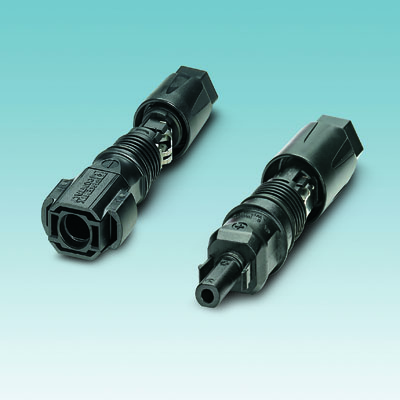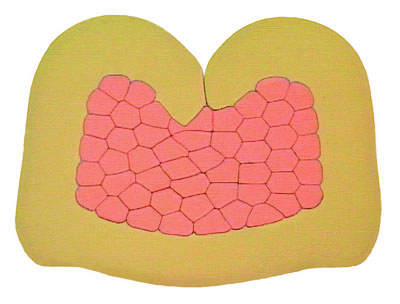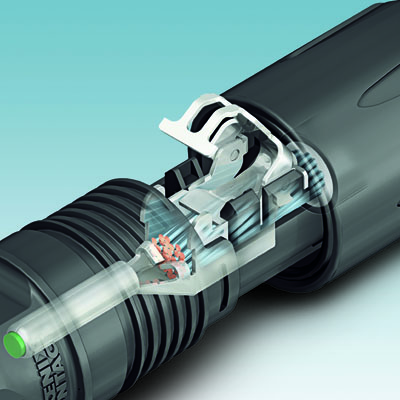PV Connectors and the National Electric Code: Preparing now for the solar storm
 As the 2014 edition of the National Electrical Code (NEC) gains further adoption within the United States, the DC photovoltaic (PV) arc-fault protection requirements of article 690.11 will gain increasing attention. The key element of article 690.11 is the automation detection and the disabling or disconnection of array components when a series arc-fault is detected. DC arc-fault protection will be required for all circuits of 80 volts or greater.
As the 2014 edition of the National Electrical Code (NEC) gains further adoption within the United States, the DC photovoltaic (PV) arc-fault protection requirements of article 690.11 will gain increasing attention. The key element of article 690.11 is the automation detection and the disabling or disconnection of array components when a series arc-fault is detected. DC arc-fault protection will be required for all circuits of 80 volts or greater.
The purpose of NEC article 690.11 is to increase the safety of PV installations by preventing fires due to DC arc-faults. Disabled or disconnected array components must be manually restarted following the detection of an arc-fault. Clearly, the best way to deal with the DC arc-fault protection requirements of NEC article 690.11 is to prevent arc-faults in the first place.
PV connectors play a critical role in the wiring of solar arrays, however, they’re also a potential source of DC arc-faults. As designed, they provide a high-voltage, high-current, low-resistance DC connection in a housing that is watertight, temperature-resilient, UV- and wire-pull-resistive, over the 25-year-plus life of the solar installation.
Connectors found on the back of PV modules are usually factory assembled. Connectors used in row-end cabling, particularly in rooftop applications, are often field-installer assembled. Many PV connectors use crimp-style contacts. Whether factory or field-installed, however, these connectors require the use of the manufacturer-recommended crimp tool and proper assembly for a trouble-free installation. As technology advances, new tool-less PV connectors have now become available. These connectors eliminate the tooling and assembly requirement by the use of a temperature- and vibration-resistant spring contact.
The mating of PV connectors from different manufacturers should also be considered. Though many connectors are considered as “compatible,” there’s currently no industry standard for a uniform connector design. As a result, some manufacturers caution against the mating of connectors that are made from different brands. Due to the differences in design tolerances, crimp tool requirements, and contact and housing materials, optimum electrical connection cannot be guaranteed.
PV connectors: Arc-fault challenges
 Arc-faults can be caused by many reasons, however, with wider implementation of the 2014 NEC, the area of improper assembly and poor PV connector contact crimps will soon take center stage as one of the prime reasons for array shutdown.
Arc-faults can be caused by many reasons, however, with wider implementation of the 2014 NEC, the area of improper assembly and poor PV connector contact crimps will soon take center stage as one of the prime reasons for array shutdown.
A recent study by the Fraunhofer Institute for Solar Energy Systems ISE of Freiburg, Germany, examined the causes of thermal failures of PV arrays. They found that connectors and crimps were the largest single cause of DC-side failures. Most of these failures occurred during the first five years of installation, leading to poor installation practices as a suspected primary cause.
Discussions in the United States with electrical inspectors have also yielded the following insights into PV connector failures, including:
- Poor contact crimps, or crimps that have grabbed some of the wire insulation;
- Incorrectly installed contacts into the connector, causing high-resistance connections; and
- Water intrusion due to improperly assembled connectors.
A number of inspectors have further observed field installers crimping PV connectors’ contacts with pliers. Others have noted a “loose” fit of PV connectors between different manufacturers.
Compounding the arc-fault failures of PV connectors are the difficulties in seeing improper assembly and poor contact crimps. Connection failures are often hidden within a seemingly acceptable connector. Outside of a complete failure, such as a distorted or melted connector, visual detection is nearly impossible. The repair costs associated with such hidden failures can be significant.
Beyond the safety aspect of PV connector failures, the triggering of DC arc-fault protection can become a contributing factor in lowering array performance, simply because of the time required to respond, diagnose, and repair such failures. Elimination of arc-fault failures is the best method of minimizing arc-fault protection economic effects.
PV connectors: Arc-fault solutions
 The key solution to the arc-fault challenges of PV connectors is to ensure the correct installation of PV connectors at the initial wiring of the array.
The key solution to the arc-fault challenges of PV connectors is to ensure the correct installation of PV connectors at the initial wiring of the array.
This can be accomplished through:
- Proper training of installers on PV connector assembly;
- Use of the proper crimp tool and methods recommended by the PV connector manufacturer; and
- The use of tool-less spring contact PV connector, eliminating the PV crimping requirement.
Beyond the issue of correct PV connector assembly or type, remains the challenge of mating field connectors to factory-installed connectors on the back of PV modules. Best practices in this area involve always specifying the same brand of field connector as that supplied by the PV module manufacturer. Module manufacturers are helping to make this easier in some cases by offering a choice of PV connector brands.
While the implementation of arc-fault protection within an array can be difficult, due to faulty PV connector installation, the use of proper training, recommended crimp tools, or even the use of a tool-less spring contact PV connectors, can help minimize the effects on array performance. The DC PV arc-fault protection requirements of article 690.11 of the 2014 NEC, combined with an arc-free PV connector installation, will go a long way to ensuring long-term performance, reliability, and safety of photovoltaic arrays.
Steve Barber is the director of Product Marketing, Device Connection, and Daniel J Sylawa is the business development manager, Renewable Energy, for Phoenix Contact USA, Inc.
Phoenix Contact USA, Inc.
www.phoenixcontact.com/us
Author: Steve Barber & Daniel J Sylawa
Volume: September/October 2014









.gif?r=3571)

.jpg?r=8014)
.jpg?r=2827)